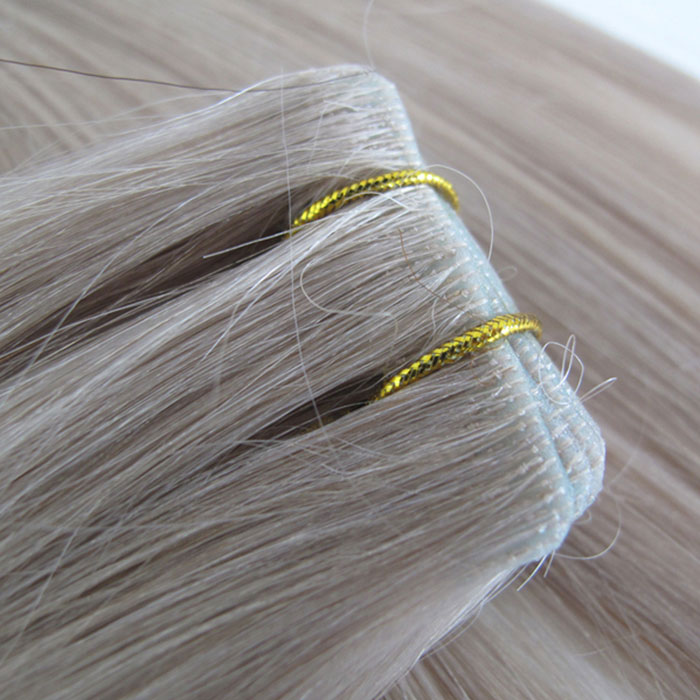Classic Tape-ins VS Hand-tied Tape-ins: A Comparative Analysis
Aug 21,2022
People usually have difficulty choosing between a classic tape-in or a hand-tied tape-in. Both methods are today's leading, semi-permanent procedures, and neither is necessarily better than the other. However, different hair types, preferences, lifestyles, and budgets may influence a person's decision to use a classic tape-in or a hand-tied extension. Enlisting the pros and cons and comparing the two methods will help you decide on the best option. This article entails everything you need to know about classic Tape-ins and hand-tied tape-ins to make an informed decision.

What is a Classic Tape-in?
Classic tape-in extensions are one to one and a half inches of sections of hair pre-glued with medical-grade glue to your hair by a professional. These extensions are made of 100% real human hair and get taped in between your natural hair in bonds. The pros of classic tape-ins include these are a good option as they work well for all hair types.
What is a Hand-tied Tape-in?
Hand-tied wefts are made up of 100% natural human hair and hand-tied into your natural hair by a row of beads. Many stylists consider these extensions a long-term solution for clients who want a clean and polished finish. These extensions create a concealed look and are less likely to show through thin or thick strands.
Installation Time for Both Methods
For hand-tied extensions, installation and reinstallation generally take more time than classic tape-in hair extensions. Installation time depends on how many tape-in packages you have installed or the number of wefts you have installed. It takes a longer time to install more hair. Generally speaking, hand tide tape-ins take twice more time to install as classic tape-in extensions. If you have to choose between the two, you must consider the factor of installation time. If you don't have any restrictions on installation time, you can go for the hand tide extensions.

Frequency of Touch-ups
For tape-in extensions, clients with thin or delicate hair need maintenance every six to eight weeks. Clients having dense or thicker hair need care every eight to ten weeks. While in the case of hand-tied extensions, clients having thin or delicate needs need maintenance every eight to ten weeks, and clients with thick hair need care every ten to twelve. You can go longer between reapplication appointments in case of hand-tied extensions. The reason is that they do not twist like tape-in extensions when they are grown out. Therefore, they remain concealed and are not visible when they grow. Hence, hand-tied tape-ins need relatively less frequent touch-up appointments or visits to salons.
Upkeep for Hand-tied VS Tape-in Extensions
Both hand-tied hair extensions and tape-ins require some upkeep to ensure they are in gorgeous condition. In the case of tape-in hair extension, it is crucial always to use paraben and sulfate-free products. These ingredients cause the tabs to slip out of the hair. These hair extensions should be gently brushed when wet because wet hair is the most fragile. Aggressive brushing can be damaging to tape-in hair extensions. Hand-tied extensions should never be left to air dry as it results in sagging of the weft. Brush them daily at the roots for return hair. Return hair is the short pieces of hair near the top of the weft, and brushing this area regularly will help you remain problem-free for a long time. Both types of extensions feel tight for a few days after application and cause sensitivity. However, you should choose the one you can keep in top condition.

Safety Concerns
Both hair extensions are damage-free when applied by a verified professional or stylist. Nevertheless, you can consider the following things when choosing a method that is right for you.
- If you are experiencing breakage in your hair, you must visit a salon to determine whether hair extensions are the right fit for you. Your stylist will likely recommend hand-tied extensions if you are experiencing minor breakage. These wefts are very thin and sewn by hand; therefore, they allow a lightweight option for your hair.
- Although tape-in hair extensions are hypo-allergic, some people have sensitive scalps and can still experience sensitivity from the adhesive. If you are a person who is allergic or sensitive to even medical-grade glue, hand-tied extensions are the right option for you.
Versatility with Hairstyles
Regarding versatility with different hairstyles, tape-in extensions allow certain hairstyles if your natural hair is at a reasonable length. On the other hand, hand-tied extensions allow for easier concealment when you wear your hair in top knots or high ponytails. Most people cannot do these hairstyles with tape-in extensions unless their hair is relatively long. You can discuss this with your hairstylist before getting the extensions; however, hand-tied extensions appear victorious in this category.
Longevity
The lifespan of all extensions depends on how well you take care of your hair. Depending on maintenance, they can last anywhere from 8 months to 1 year or even longer. To extend the lifetime of your extension, deep conditioning and frequent trimming are required for both hand tide hair extensions and classical tape-ins. Hand-tied hair extensions can last longer than tape-ins because the wefts do not have a bond that is likely to break down over time. In the case of tape-ins, the bonds break after a specific time even if you take good care of your hair. All extensions have an expiry date. However, some of them can last a bit longer than others, given the very nature of their construction.
Takeaway
Both hand-tied and classical tape-ins have their pros and cons. It is always advisable to visit a professional stylist before you decide what the best option for you to go with is. Choosing an extension depends on your preferences, budget, lifestyle, and hair type is the best idea.




